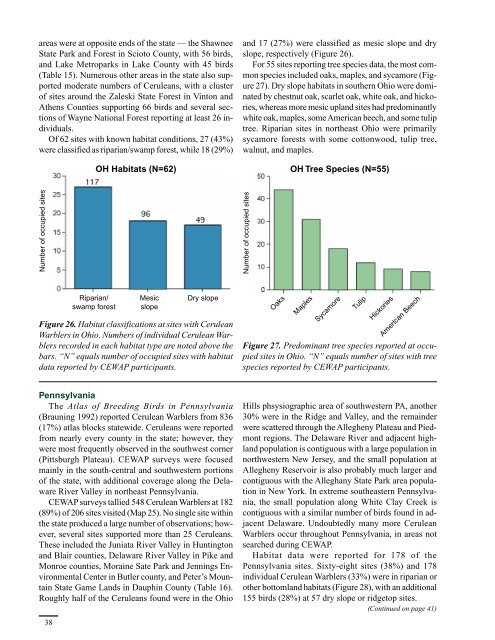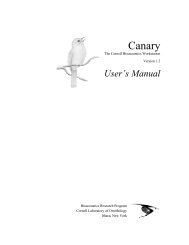An Atlas of Cerulean Warbler Populations - Cornell Lab of Ornithology
An Atlas of Cerulean Warbler Populations - Cornell Lab of Ornithology
An Atlas of Cerulean Warbler Populations - Cornell Lab of Ornithology
Create successful ePaper yourself
Turn your PDF publications into a flip-book with our unique Google optimized e-Paper software.
areas were at opposite ends <strong>of</strong> the state — the ShawneeState Park and Forest in Scioto County, with 56 birds,and Lake Metroparks in Lake County with 45 birds(Table 15). Numerous other areas in the state also supportedmoderate numbers <strong>of</strong> <strong>Cerulean</strong>s, with a cluster<strong>of</strong> sites around the Zaleski State Forest in Vinton andAthens Counties supporting 66 birds and several sections<strong>of</strong> Wayne National Forest reporting at least 26 individuals.Of 62 sites with known habitat conditions, 27 (43%)were classified as riparian/swamp forest, while 18 (29%)OH Habitats (N=62)and 17 (27%) were classified as mesic slope and dryslope, respectively (Figure 26).For 55 sites reporting tree species data, the most commonspecies included oaks, maples, and sycamore (Figure27). Dry slope habitats in southern Ohio were dominatedby chestnut oak, scarlet oak, white oak, and hickories,whereas more mesic upland sites had predominantlywhite oak, maples, some American beech, and some tuliptree. Riparian sites in northeast Ohio were primarilysycamore forests with some cottonwood, tulip tree,walnut, and maples.OH Tree Species (N=55)Number <strong>of</strong> occupied sitesNumber <strong>of</strong> occupied sitesRiparian/swamp forestMesicslopeDry slopeFigure 26. Habitat classifications at sites with <strong>Cerulean</strong><strong>Warbler</strong>s in Ohio. Numbers <strong>of</strong> individual <strong>Cerulean</strong> <strong>Warbler</strong>srecorded in each habitat type are noted above thebars. “N” equals number <strong>of</strong> occupied sites with habitatdata reported by CEWAP participants.OaksMaplesSycamoreTulipHickoriesAmerican BeechFigure 27. Predominant tree species reported at occupiedsites in Ohio. “N” equals number <strong>of</strong> sites with treespecies reported by CEWAP participants.PennsylvaniaThe <strong>Atlas</strong> <strong>of</strong> Breeding Birds in Pennsylvania(Brauning 1992) reported <strong>Cerulean</strong> <strong>Warbler</strong>s from 836(17%) atlas blocks statewide. <strong>Cerulean</strong>s were reportedfrom nearly every county in the state; however, theywere most frequently observed in the southwest corner(Pittsburgh Plateau). CEWAP surveys were focusedmainly in the south-central and southwestern portions<strong>of</strong> the state, with additional coverage along the DelawareRiver Valley in northeast Pennsylvania.CEWAP surveys tallied 548 <strong>Cerulean</strong> <strong>Warbler</strong>s at 182(89%) <strong>of</strong> 206 sites visited (Map 25). No single site withinthe state produced a large number <strong>of</strong> observations; however,several sites supported more than 25 <strong>Cerulean</strong>s.These included the Juniata River Valley in Huntingtonand Blair counties, Delaware River Valley in Pike andMonroe counties, Moraine Sate Park and Jennings EnvironmentalCenter in Butler county, and Peter’s MountainState Game Lands in Dauphin County (Table 16).Roughly half <strong>of</strong> the <strong>Cerulean</strong>s found were in the Ohio38Hills phsysiographic area <strong>of</strong> southwestern PA, another30% were in the Ridge and Valley, and the remainderwere scattered through the Allegheny Plateau and Piedmontregions. The Delaware River and adjacent highlandpopulation is contiguous with a large population innorthwestern New Jersey, and the small population atAllegheny Reservoir is also probably much larger andcontiguous with the Alleghany State Park area populationin New York. In extreme southeastern Pennsylvania,the small population along White Clay Creek iscontiguous with a similar number <strong>of</strong> birds found in adjacentDelaware. Undoubtedly many more <strong>Cerulean</strong><strong>Warbler</strong>s occur throughout Pennsylvania, in areas notsearched during CEWAP.Habitat data were reported for 178 <strong>of</strong> thePennsylvania sites. Sixty-eight sites (38%) and 178individual <strong>Cerulean</strong> <strong>Warbler</strong>s (33%) were in riparian orother bottomland habitats (Figure 28), with an additional155 birds (28%) at 57 dry slope or ridgetop sites.(Continued on page 41)
















